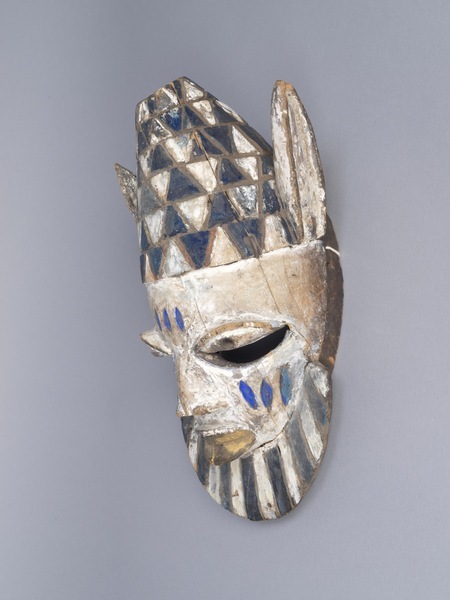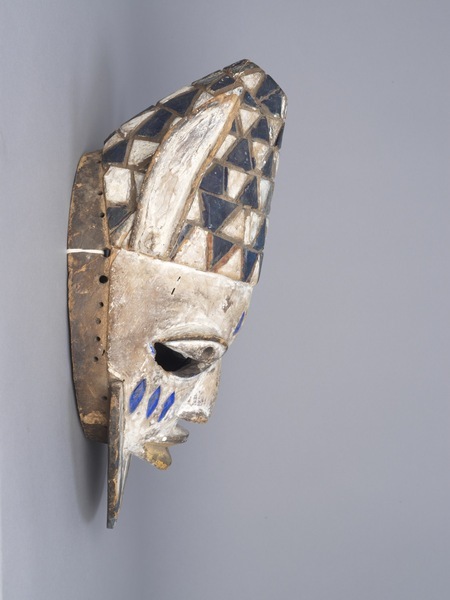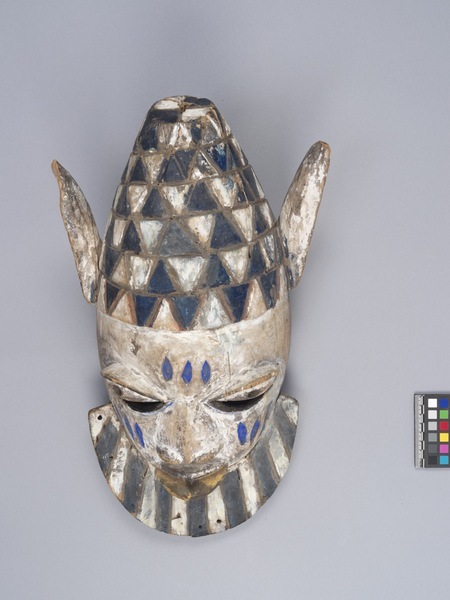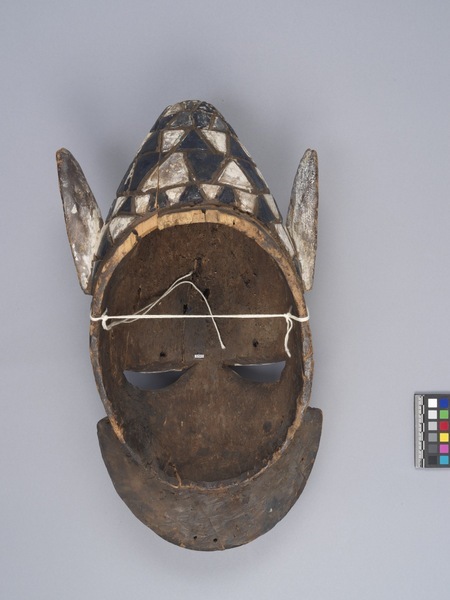Gelede Mask Item Number: 3294/3 from the MOA: University of British Columbia




Description
Wooden mask. Face is painted white, with three repeating blue diamonds on each cheek and across the forehead. The mask has large lips, raised nose, and protruding eyes, with holes drilled through the pupils, and areas cut out underneath both eyes. Long ears extend up each side of the head. The figure has a cone-shaped hat with repeating triangles in blue or white, and a collar extending out from below the chin with white and dark blue vertical stripes.
History Of Use
The gélède mask is worn more like a headdress, on top of the head, by male dancers. The masks are worn during Yoruba Gelede festivals which honour women, both living and dead, in particular the powerful "Mothers" (awon iya wa), a group that includes female ancestors and deities, as well as elderly women of the community. When dancers perform the Gelede dance they are displaying the powers of their female ancestors, who are considered to the beginning of the nation, makers of community and the protectors of children. They have the ability to affect the wellbeing of individuals or the community in positive and negative ways. The Gelede ceremony is divided into two parts: the efe, which takes place at night and features a humorist praying for the community, and the ijo osan, the daytime dance that is commonly referred to as Gelede.
Narrative
Purchased by the donor's wife in 1993, in Germany, from the auction house 'Ketterer Kunst Munchen'.
Iconographic Meaning
One narrative for the origin of the Gelede dance is that after Yemoja, the water goddess and mother of all spirits, performed a spirit dance by the river she gave birth to two children. Her daughter was a dancer and was called Gelede because of her weight; Yemoja’s son was called Efe because he was a humorist. The names of the children and their traits could then inform the parts of the Gelede ceremony. Female gelede masks are larger and are used for dancing, and the efe nighttime ceremony involves a humorist. In Yoruba culture, beards are commonly symbols of wisdom, experience and advanced age. The colour white is regarded as sacred, as it is the predominant colour of the Great Mother mask (Iya Nla) and other masks associated with her. The colour also symbolizes the link of the Efe mask wearer to the physical and spiritual worlds; the colour also allows for the wearer to be seen better at nighttime. This type of Efe mask is an Àgàsa mask, known for its diagonal or horizontal painted stripes. The pointed ears are inspired by Etíyerí (long-eared) Egungun masks.
Cultural Context
Gelede festival dances.
Item History
- Made in Nigeria
- Owned by Frank Heinzelmann before March 27, 2018
- Received from Frank Heinzelmann (Donor) on March 27, 2018
What
Who
- Culture
- Yoruba
- Previous Owner
- Frank Heinzelmann
- Received from
- Frank Heinzelmann (Donor)
Where
- Holding Institution
- MOA: University of British Columbia
- Made in
- Nigeria
When
- Ownership Date
- before March 27, 2018
- Acquisition Date
- on March 27, 2018
Other
- Condition
- fair
- Accession Number
- 3294/0003